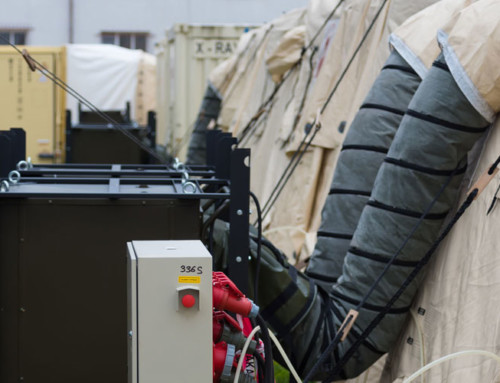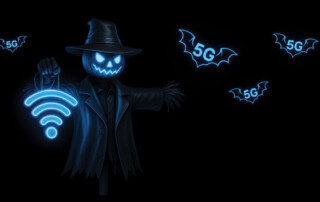Commercial Mobile Networks have been around for over thirty years. They began as simple voice networks but have evolved to sophisticated data networks where voice is but one of the many applications supported by the network. Those early voice networks were analog based: AMPS in North America, TACS/ETACS/JTACS in Europe and Japan, and NMT in the Nordic countries. As mobile voice networks picked up popularity, digital voice networks replaced these analog networks. The digital networks were based on a variety of different standards, however most deployments worldwide were based on standards being developed by two global initiatives. The Third-Generation Partnership Project (3GPP) developed the GSM family which evolved to HSPA and eventually LTE. GSM based networks were deployed all over the world and were the basis of the largest percentage of mobile networks deployed worldwide. In a parallel effort, separate but similar affiliated groups, the International Telecommunications Union (ITU) and later The Third-Generation Partnership Project 2 (3GPP2) developed the CDMA family which evolved to EVDO. CDMA based networks made up the second largest percentage of mobile networks deployed worldwide.
Mobile networks continued to evolve and the 3GPP, 3GPP2 and a new entrant in the broadband mobile network space, the Institute of Electrical and Electronic Engineers (IEEE) who developed the standards for Wi-Fi, competed to develop and gain adoption of new 4G network standards.
| Generation | Standards Organization | Technology |
| 1G | AMPS, TAC, ETAC, JTAC, NMT | |
| 2G | 3GPP | GSM |
| ITU | cdmaOne | |
| 3G | 3GPP | UTMS |
| 3GPP2 | CDMA2000 1xEV-DO Rev 0 | |
| 4G | 3GPP | LTE Advanced |
| 3GPP2 | UMB | |
| IEEE | WiMAX |
Mobile Network Progression
The 3GPP2, which included standards bodies from around the globe representing CDMA networks, developed a 4G network standard called Ultra Mobile Broadband (UMB) or EV-DO Rev C. UMB was based on an IP connected core with a next generation radio network using advanced techniques such as Orthogonal Frequency Division Multiplexing (OFDM) and Multiple Input Multiple Output (MIMO) to obtain peak data rates up to 280 Mbps. Due to lack of interest by the major CDMA network operators, UMB development was abandoned and no commercial networks were ever deployed.
IEEE an organization whose standards attained worldwide adoption for the deployment of WLANs developed a 4G WAN standard called WiMAX. WiMAX was intended to leverage the popularity of Wi-Fi as a complementary standard. WiMAX was designed such that Wi-Fi devices would connect to WiMAX subscriber nodes therefore enabling the use of existing Wi-Fi devices and making it easy for user adoption. WiMAX was deployed in a few countries with moderate early success however lost momentum after a short period of time.
The 3GPP developed a standard called Long Term Evolution or more commonly known as LTE. The initial definition did not meet the IMT-Advanced requirements of a 4G network, however the 3GPP developed enhancements called LTE Advanced which make LTE a true 4G network standard. LTE shares several similarities to the 3GPP2 UMB standard such as OFDM and MIMO and were both thought to prevail as a widely adopted 4G network standard. However, both standards required the introduction of new network components requiring significant investments for mobile network operators. Due to the overwhelmingly larger eco-system around the 3GPP GSM family of networks, mobile network operators around the globe began committing to LTE to avoid the disadvantage of having a higher network deployment cost resulting from a smaller scale. LTE is the most commonly adopted 4G network standard and has been deployed almost exclusively in mobile networks around the world. With most mobile networks worldwide based on LTE, this is the first time when essentially the entire mobile industry is focused around one standard.
One globally adopted mobile network standard has a lot of advantages. The most obvious is the basis of interoperability between mobile network operators. Should mobile operators choose to establish connectivity between their networks, the capability exists to allow uninterrupted service between networks. Other advantages include the accelerated development of enhancement features, the more efficient manufacturing of chipsets and the rapid development of network deployment tools. Collectively these advantages along with the entire 4G LTE ecosystem have allowed mobile network operators, device manufacturers and network equipment manufacturers to provide feature rich 4G network services to users at a faster pace and lower cost.
In fact, 4G networks are growing so fast, mobile network operators are constantly adding spectrum – upgrading their networks to implement capacity enhancing features and densifying their networks. The demands to continually add network capacity are so intense that many mobile network operators have had to prioritize capacity enhancements over coverage expansions especially in indoor applications where strain on network resources aren’t being caused by a lack of indoor coverage. Solutions for indoor coverage often consist of distributed antenna systems and small cell solutions. These indoor solutions are often costly and almost always require the mobile network operators to participate in some capacity. If a solution were to exist allowing private enterprise to take advantage of the 4G LTE ecosystem and to build and deploy sharable LTE networks, it could rapidly improve indoor wireless coverage in a shared cost model acceptable to mobile network operators and private enterprise alike.
Today, LTE networks are almost exclusively deployed in licensed spectrum by mobile network operators who pay billions of dollars to lease spectrum from government spectrum regulators. Although there has been movement with LTE-U and LTE-AA to utilize unlicensed spectrum it has been targeted for mobile operators as a feature to extend the capacity of their existing licensed based networks. But this could soon change. The MulteFire Alliance completed Release 1 of their specification for an LTE-based technology operating in unlicensed spectrum. Utilizing MulteFire technology non-mobile operators will have opportunities to deploy LTE networks in unlicensed spectrum.
In addition, in April 2015, the Federal Communications Commission (FCC), spectrum regulatory body of the United States, issued a Report and Order establishing the creation of the Citizens Broadband Radio Service (CBRS). And with the creation of CBRS established rules allowing the spectrum to be shared among multiple users such as mobile network operators and non-mobile network operators seeking to utilize the spectrum for private industry needs. What makes CBRS unique is that it opens the use of 3.5 GHz spectrum in the US, spectrum anticipated to be available in many other countries soon, for LTE. In the US, the spectrum will be shared among exclusive licensees, priority licensees and general authorized access users. It is unknown how the spectrum will be used in other countries.
With the expected global availability of the 3.5 GHz spectrum, a group of wireless technology companies have formed the CBRS Alliance to promote the development of LTE-Based solutions, including multi-operator solutions, utilizing this spectrum. The CBRS Alliance began with six companies (Access Technologies (Alphabet), Federated Wireless, Intel, Nokia, Qualcomm and Ruckus Wireless (now part of Brocade)) but has now expanded to over 40 companies including some of the largest mobile network operators.
In prompting the development of LTE-Based solutions in the 3.5 GHz band, the CBRS Alliance is working in cooperation with the Wireless Infrastructure Forum to develop technology and standards which will not only allow LTE networks to utilize the 3.5 GHz spectrum but also to share the spectrum and prevent interference with incumbent government systems. Among the technology being developed are the Spectrum Access System (SAS), Environmental Sensing Capability sensors (ESC) and Citizen Broadband Radio Service Devices (CBSDs). In addition, development is being focused on building LTE core components of the appropriate size and scale for enterprise applications versus mobile operator networks.
As the key components of a CBRS or MulteFire solution become available along with devices, the creation of private LTE networks becomes a viable solution for private building owners to build and manage wireless coverage within their buildings, and for mobile network operators to access these private networks as Neutral Host Network Providers.
Private LTE networks have the potential to redefine the approach to indoor coverage. Today, building owners and managers commonly deploy Wi-Fi at the building owner or manager’s expense to allow employees, tenants or customers to access public internet or private network services. This is largely because Wi-Fi is common in most user devices, the spectrum is accessible without a license and the service is recognized as an essential business requirement. However, use of Wi-Fi still requires awkward authentication protocols which deter or prevent some users from accessing the available Wi-Fi networks. For those users they continue to use mobile operator networks which can lack sufficient coverage or capacity within indoor spaces.
These barriers or biases which have prevented the deployment of Private LTE Networks in the past are being address. Private LTE networks will simplify authentication prompting users to utilize the Private LTE network rather than the mobile operator networks and will offer similar features and functionality. As standards are defined around the use of LTE within CBRS and MulteFire, gaps in interoperability will be addressed. Within the next few years it is expected that building owners, managers or non-mobile network operators will have access to spectrum and devices to launch their networks. Given the large eco-system around 4G LTE, the technology development with CBRS and MulteFire, Private LTE networks will soon offer the needed coverage and capacity within indoor spaces and as well as a transparent experience for users.























Leave A Comment